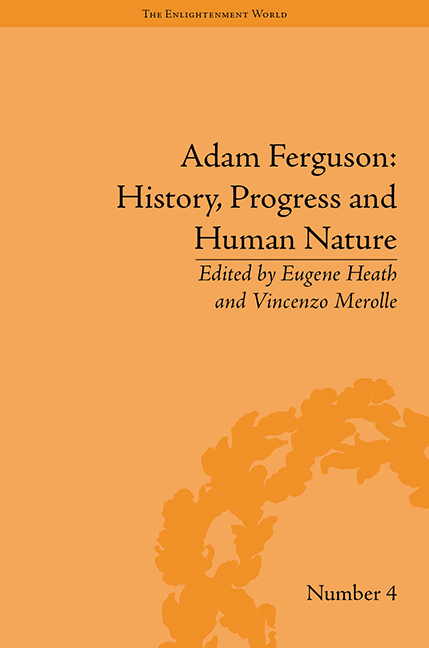Book contents
- Frontmatter
- CONTENTS
- Contributors
- Introduction
- I Life and Works
- II In History
- 4 Ferguson's Reflections Previous to the Establishment of a Militia
- 5 Ferguson's Views on the American and French Revolutions
- 6 Political Education for Empire and Revolution
- III On History
- IV Human Nature, Action and Progress
- Notes
- Works Cited
- Index
5 - Ferguson's Views on the American and French Revolutions
from II - In History
- Frontmatter
- CONTENTS
- Contributors
- Introduction
- I Life and Works
- II In History
- 4 Ferguson's Reflections Previous to the Establishment of a Militia
- 5 Ferguson's Views on the American and French Revolutions
- 6 Political Education for Empire and Revolution
- III On History
- IV Human Nature, Action and Progress
- Notes
- Works Cited
- Index
Summary
On 9 March 1776, The Wealth of Nations was published in London. Its author, Adam Smith, outlined the framework of a rising new economic world, and concluded his voluminous book with these words:
If any of the provinces of the British empire cannot be made to contribute towards the support of the whole empire, it is surely time that Great Britain should free herself from the expence of defending those provinces in time of war, and of supporting any part of their civil or military establishments in time of peace, and endeavour to accommodate her future views and designs to the real mediocrity of her circumstances.
Several months later, on 4 July, across the Atlantic, the American colonists proclaimed in the Declaration of Independence, ‘that these United Colonies are, and of Right ought to be Free and Independent States; that they are Absolved from all Allegiance to the British Crown’. Although Smith proposed to ‘the rulers of Great Britain’ that ‘If the project [for possessing a great empire on the west side of the Atlantic] cannot be compleated, it ought to be given up’, he does not appear to have defended passionately the cause of American independence, or to have supported the rebel Americans. David Hume, who wrote to Baron Mure of Caldwell that ‘I am an American in my Principles, and wish we woud let them alone to govern or misgovern themselves as they think proper’, welcomed the proposal of some ministers in council that ‘both Fleet and Army be withdrawn from America’. Hume, however, died on 25 August 1776, shortly after the signing of the Declaration of Independence.
One of the signatories to that Declaration was John Witherspoon, an emigrant Scot born in 1723 (the same year as Smith), and one of the representatives of New Jersey to the Continental Congress. Having endeavoured to justify the independence of America in his writings and sermons, Witherspoon took ‘an active part in the debate leading to the adoption of the Articles of Confederation in the late 1770s’.
- Type
- Chapter
- Information
- Adam FergusonHistory, Progress and Human Nature, pp. 73 - 86Publisher: Pickering & ChattoFirst published in: 2014



